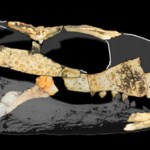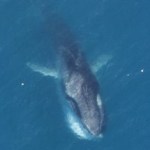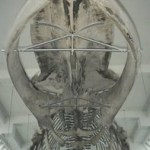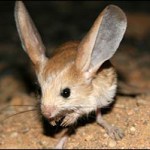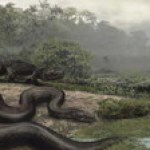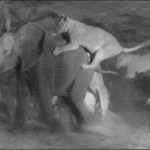From the Archives
In the previous post we looked at the small, island dwelling crocodilians of the south-west Pacific. I personally find it exciting that such animals were (in the case of at least some of the species) alive until just a few thousand years ago, that they were encountered by people, and that their remains have eluded detection until recent decades. The odds are high that further species await discovery. Here's another article that originally appeared at Tet Zoo ver 1.
Before we get to the new stuff, here's something relevant to the mekosuchine article: a never-before-seen skull reconstruction…
Here's an interesting contention: until just a few thousand years ago, small crocodilians inhabited the tropical islands of the South Pacific and elsewhere. In fact, judging from recent discoveries, small terrestrial crocodilians were an ordinary component of many tropical island groups, and they presumably still would be, had they not been made extinct by people. This article originally appeared in 2006 on Tet Zoo ver 1, and here it is again...
The first of these animals to be discovered was Mekosuchus inexpectatus from New Caledonia (life restoration shown above), a species that most…
Not only am I now unable to edit my blogroll (a very minor thing, but one that bugs me nonetheless), I am also incapable of understanding how ResearchBlogging is supposed to work. I registered, but cannot get my posts to appear there, so am going to give up. Oh well, it's not like it matters I suppose (hmm, or does it?). Am currently busy with the books, and am also (with co-authors) putting the finishing touches to some very neat papers... on which all will be revealed in due time. Anyway, to business, and to the last of those rorqual articles. Please see part I and part II first. The…
More on those rorquals: part I is required reading. To those who have seen this stuff before: sorry, am going through a busy phase and no time for new material (blame dinosaurs and azhdarchoid pterosaurs... and baby girls). Oh, incidentally, I recently registered Tet Zoo with ResearchBlogging: I haven't done this before because 'blogging on peer-reviewed research' is the norm at Tet Zoo, not the exception. It seems to take ages for posts to be uploaded to ResearchBlogging - like, hours. Is this normal? Anyway...
This time we look at the basics of rorqual morphology and at their feeding…
Sorry, nothing new: time again for something from Tet Zoo ver 1...
Late in the 1920s, plans to replace the old whale hall of the British Museum (Natural History) were fulfilled. Thanks to the new, steel-girdled hall, the Blue whale skeleton - by now kept in storage for 42 years due to lack of space - could finally be put on display [adjacent image, © NHM]. This skeleton belonged to a 25 m animal that had stranded at Wexford Bay, SE Ireland, in 1891. It - as in, the skeleton alone - weighs over 10 tons. But some people at the museum wanted more, and in 1937 taxidermist Percy Stammwitz (1881-…
More stuff from the archives... or, from Tet Zoo ver 1 anyway. The following article is about the bizarre jerboa Euchoreutes naso. Back when I wrote the article (2006), there were no photos of this species available, and I had to resort to using a single painting. However, a glut of good photos are now available, as explained below. Incidentally, do not ever google the term 'Asian wild life'.
-------------------------------------------------
It's funny how things work out. Today I am obsessed with rodents. Why? Most of my day was spent clearing out an old loft, and while rummaging through…
In a fairly hilarious slip, yesterday a USA Today said researchers had found a 2500 foot snake fossil in Colombia.  Uh, make that a 2500 pound snake (it was about 40 feet long). But still:  BIG SNAKE!!  And it was 65 million years old (OLD SNAKE!!).  The Independent's headline called it, "The Snake That Was So Big it Ate Crocodiles."  But that's actually not news: Plenty of snakes eat things like crocodiles. And that sometimes gets very ugly ...Â
Here, from the Culture Dish archives, is the disturbing news about what can happen when a snake…
Yesterday, one of my dogs got into a stash of chocolate (sigh), which had me up at 2am doing the dreaded hydrogen peroxide trick, since chocolate is toxic to dogs. When I complained about my night a friend sent me this link (!!) saying, Just be glad your dog didn't eat a kitchen knife (which is always something to be glad about).  The x-ray image in that story (left) reminded me that it was high time I posted this rom the Culture Dish archives:Â
-----------------------------------------------------------------------------------
I've always had a thing for animal x-…
In 2006, the second series of the BBC's Planet Earth was screened. If you saw the series, you'll know that it included a lot of awesome stuff. One thing that got an awful lot of people talking was the amazing footage - included as part of episode 2 ('Great Plains') - showing the elephant-killing lions of Savuti in Chobe National Park, northern Botswana. I wrote about this footage at Tet Zoo ver 1 back in November 2006 (it's here), and - for those who didn't see it first time round - here it is again...
While most people 'know' that elephants are immune to predation thanks to their size,…
'... [it] clambers up and down trees because it cannot fly ... it purrs like a cat and smell like a posy of fragrant flowers ... it allows itself to be picked up and handled without demur or apparent concern' (Vietmeyer 1992, p. 69).
Another Ten Bird Meme bird (use the search bar if you need more information on that concept). Sometimes called the Owl parrot, the Kakapo Strigops habroptilis was first described by John Gray in 1845 [adjacent image is John Keulemans's painting of 1873]. Everything about the Kakapo is extraordinary. It's a large, nocturnal, cryptically-coloured, terrestrial…
Every time I see that someone has joined the Six Degrees of Separation experiment group on Facebook (which now has more than 2.5 million people in it), I think about something I posted about on Culture Dish a few years ago: At this point, pretty much everyone knows the theory of Six Degrees of Separation:
That everyone in the world somehow connected through a chain of six
people. What most people don't know is, the results from the study that supposedly
proved the theory were seriously flawed ...
The phrase "Six Degrees of Separation" was coined by inspired by a study by Stanley Milgram…
Here's some good solid (and useful) science for you: Researchers in
Liverpool have announced that "being pelted by a raw egg may
result in eye injury." How they know: They studied the medical records
of 18,651 patients who'd gone to an eye unit over the course of 14
months. Thirteen turned out to be egg attack victims. As the BBC reported:
"The
researchers warn that egg hurling, sometimes used as a form of protest
or prank, is far from harmless. They point out, in the Emergency
Medical Journal, that an egg has the same dimensions as a squash ball
but carries even more weight when lobbed.…
Yesterday was the first day I was able to post since the ScienceBlogs upgrade because of glitches in the system. Now I'm headed off to Durham, NC, until Sunday. More below the jump:
I'll be visiting a Duke science journalism class and speaking about my book at a Women in Science and Engineering event on Friday. Then Saturday I'll be at the ScienceOnline09 conference talking about
blogging
and breaking into print publication. I'll post from the road if there
are any breaking developments related to the assistance creature story I wrote for the New York Times Magazine,…
I like ducks, and I particularly like steamer ducks. Again, here we revisit some Tet Zoo ver 1 text that was originally published in 2006 as part of the Ten Birds Meme.
The most widely distributed of the four Tachyeres species*, the Flying steamer duck T. patachonicus inhabits both the fresh and marine waters of the Falklands and southern Patagonia and Tierra del Fuego. While all other steamer-ducks are flightless, T. patachonicus is (obviously) not, and in contrast to its flightless relatives it has proportionally bigger pectoral muscles and lower wing loadings. But what makes the species…
More from the archives - and again this is from the Ten Bird Meme of 2006.
If convergence is one of the most interesting evolutionary phenomena, then the Ground tit Pseudopodoces humilis should become a text-book example of it, on par with thylacines vs wolves and ichthyosaurs vs dolphins [adjacent photo from here]. Described in 1871 by A. Hume, the Ground tit is a weak-flying brown passerine of the Tibetan plateau, often superficially likened to a wheatear. But for most of the time that we've known of it, it has not gone by the name Ground tit at all: rather, it has been termed Hume's…
Another article from the archives, written back on April 19th 2006. Two days earlier I'd sat up watching BBC4's night of primate documentaries, and that where our story begins...
I've sat up and watched such things as 'Natural History Night' and 'Dr Who Night' before - usually they're a con, the programmes fizzling out round about 10-30, but 'Primates Night' (err, if that's what it was called) wasn't so thrifty, keeping me in front of the TV until past 01-00 at least. And it was brilliant - the best assortment of TV programmes I've seen since, well, ever.
The first episode of the BBC series…
Another bit of text from the Ten Bird Meme of 2006. This time: well, you already know... also called the Shoe-billed stork, She-billed stork [not a typo], Whale-bill or Whale-headed stork, Balaeniceps rex is a long-legged big-billed waterbird of central Africa, and a specialist denizen of papyrus swamps. Though known to the ancient Egyptians, it wasn't described by science until John Gould named it in 1851. Before that time it was a cryptid, as an 1840 sighting of this as-of-then-unidentified bird had been published by Ferdinand Werne in 1849 (Shuker 1991).
Standing 1.4 m tall, the Shoebill…
Another one from the archives. It's one of several articles I wrote in 2006 on obscure tropical rodents, was originally published here, and appears here with new pics and a few new details...
If you've read Scott Weidensaul's excellent book The Ghost With Trembling Wings (2002), you'll recall the story of Louise Emmons and the giant Peruvian rodent she discovered. But before I get to that, let me say that The Ghost With Trembling Wings isn't about ghosts at all, but about the search for cryptic or supposedly extinct species. Think thylacines, British big cats, Ivory-billed woodpeckers, Cone-…
Another one from the archives, and another one from my rodent phase of 2006 (originally published here): despite efforts, I was simply unable to even scratch the surface of what is the largest extant mammalian 'Order'. Where appropriate I've added updates and have uploaded new images.
Though new rodents are described from all over the place (yes, even from North America and Europe*), I had a recollection of the greatest percentage coming from South America. And indeed there are quite a few (note that some of the following don't have common names), with a randomly-selected list of my…
Back in 2006 I took part in the 'ten birds' meme. If infected (do people normally speak of being 'infected' by memes?), you were supposed to write about ten birds that you found 'beautiful'. I decided to distort it slightly and make the birds the ten that I found most 'beautifully interesting'. Here's one of them, the others may or may not follow too.
Originally described by DeVis in 1890 as Todopsis kowaldi, Ifrita was independently 'discovered' by Walter Rothschild in 1898 and named by him Ifrita coronata. A passerine endemic to moist montane forests on New Guinea, Ifrita is remarkable for…
